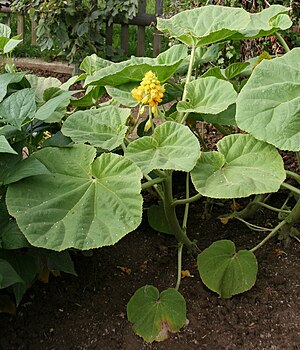Ibicella
| Ibicella | ||||||||||||
|---|---|---|---|---|---|---|---|---|---|---|---|---|

Flowered example of Ibicella lutea |
||||||||||||
| Systematics | ||||||||||||
|
||||||||||||
| Scientific name | ||||||||||||
| Ibicella | ||||||||||||
| ( Stapf ) van Eselt. |
Ibicella is a genus of plants from the chamois horn family( Martyniaceae ). It comes from the New World and includes only two types.
description
Annual plants with taproots , the stems of which grow upright to lying flat. The leaves are broadly oval to semicircular and whorled to opposite. The blades are whole or finely toothed, the tips of the leaves are blunt, rounded to round-pointed. The leaf bases are heart-shaped and even. The inflorescences are many-flowered, they tower above the foliage; the bracts are oblong to triangular. The five-fold flowers have a yellow corolla and are two-lipped, the constricted part of the flower tube is surmounted by the bell-shaped and free sepals , the enlarged part is bulbous to obliquely funnel-shaped. The bracts are elongated to round and sloping. The inside of the flower tube, the throat is decorated with orange to chestnut-red spots and sap marks . The petals are widely spread and have fewer or no noticeable spots. In the flowers there are four didynamic stamens and a staminode. The backed by a nectar disc ovary is upper constant with numerous ovules . The long-beaked fruits are oblong-egg-shaped with sloping meso- and exocarp , the fruit capsule is slightly split open and has spikes, a small crest runs along the seam. The curved "horns" are 1.25 to 2 times as long as the woody capsule itself. The seeds are numerous, black or gray, and have a corky shell. The fruits spread as trample ( epizoochory ). The hardened tips and horns clasp the hooves or paws of larger mammals like pincers, or they get caught in the fur, and occasionally in the shoes of careless hikers. The involuntary "spreaders" crush the hard capsules and thus set the seeds free.
The genus is classified as precarnivorous . Almost all of the plants are hairy, sticky with a strong odor. In both species, the plants are almost completely covered with sticky stem glands, which catch small insects in large numbers but cannot digest them on their own. The stickiness of the plants is very likely more of a protection against animal damage than a real trap.
The number of chromosomes is 2n = 30 or 32.
distribution
Ibicella lutea is native to Brazil , Bolivia , Argentina , Paraguay and Uruguay , but was naturalized within the New World in the US states of California , Florida , Georgia and Mississippi . Outside the New World, it appears as a neophyte in Algeria , South Africa and Australia . It grows in open, sunny areas and prefers moist, sandy soils. Ibicella parodii grows exclusively on the eastern foothills of the Andes in Argentina, Bolivia and on the extreme western border of Paraguay. It grows preferentially in open and sunny, semi-arid deserts and salt deserts, for example in the Gran Chaco region in Paraguay.
Systematics
The genus Ibicella was established in 1929 by Glen Parker van Eseltine . The generic name Ibicella is borrowed from the Latin Ibex for "ibex" and refers to the curved "horns" of the fruit capsules. The genus includes the following species:
- Ibicella lutea (Lindl.) Van Eselt. ; Yellow unicorn flower, yellow devil's claw, chamois horn; Syn. Martynia lutea Lindl. , Proboscidea lutea (Lindl.) Stapf , Martynia montevidensis Cham. , Ibicella nelsoniana ( Barb . Rodr .) Van Eselt. , Martynia nelsoniana Barb . Rodr . It is originally found in Brazil, Argentina, Paraguay and Uruguay.
- Ibicella parodii Abbiatti ; Devil's Claw, Pepino silvestre, Cuerno del diablo. It was first described from Argentina.
literature
- Raul Gutierrez: A Phylogenetic Study of the Plant Family Martyniaceae (Order Lamiales). Dissertation, Arizona State Univ., December 2011, pp. 97 ff. Online (PDF; 41.7 MB). at ASU Digital Repository.
- Joachim W. Kadereit , K. Kubitzki : Flowering Plants · Dicotyledons: Lamiales (except Acanthaceae including Avicenniaceae) (= The Families and Genera of Vascular Plants. Volume 7). Springer, Berlin / New York City 2004, ISBN 3-540-40593-3 .
Individual evidence
- ↑ a b c d Raul Gutierrez: A Phylogenetic Study of the Plant Family Martyniaceae (Order Lamiales). 2011, p. 97.
- ↑ Joachim W. Kadereit, K. Kubitzki: Flowering Plants · Dicotyledons. 2004, p. 288.
- ^ WP Armstrong: Devil's Claws: Hitchhikers On Big Animals. Internet article on palomar.edu (English); last accessed on October 3, 2018.
- ↑ When do we speak of precarnivory? at online.uni-marburg.de, accessed on October 3, 2018.
- ^ Aaron Ellison, Lubomír Adamec: Carnivorous Plants: Physiology, ecology, and evolution. Corrected Reprint, University Press, Oxford 2018, ISBN 978-0-19-877984-1 , pp. 37, 172.
- ↑ Joachim W. Kadereit, K. Kubitzki: Flowering Plants · Dicotyledons. 2004, p. 288.
- ^ Ph. Munz, D. Keck: A California Flora. Univ. of California Press, 1970, ISBN 0-520-00897-9 , p. 679.
- ^ Diego Sebastián González, Maricel Celia Gutiérrez: Plantas de los Salares del Chaco Árido. 2014, ISBN 978-1-312-06944-2 , p. 36 f.
- ^ Raul Gutierrez: A Phylogenetic Study of the Plant Family Martyniaceae (Order Lamiales). 2011, p. 98.
- ↑ Ibicella in the Germplasm Resources Information Network (GRIN), USDA , ARS , National Genetic Resources Program. National Germplasm Resources Laboratory, Beltsville, Maryland. Retrieved December 13, 2018.
- ^ Raul Gutierrez: A Phylogenetic Study of the Plant Family Martyniaceae (Order Lamiales). 2011, p. 103.